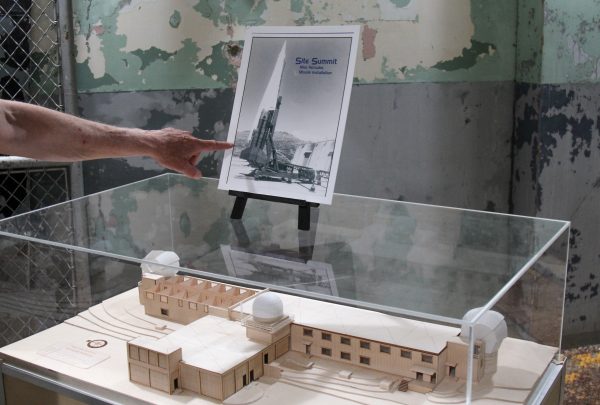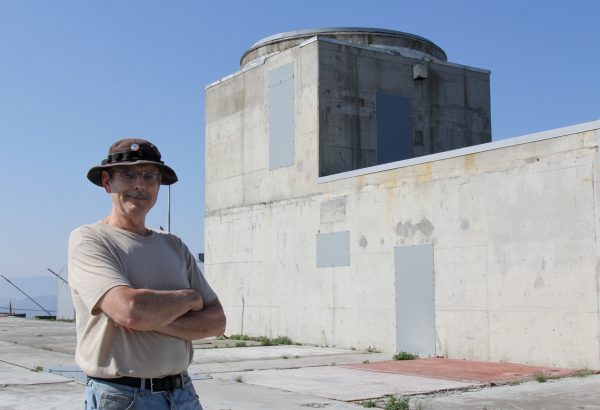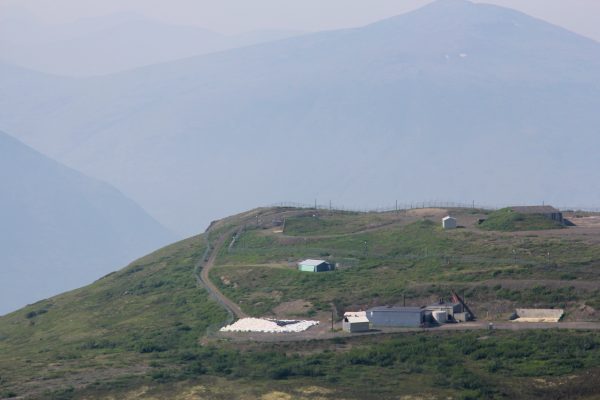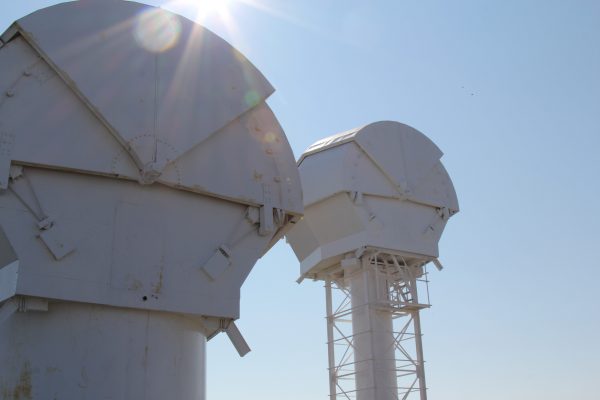
It might seem hard to believe, just a few decades ago thousands of nuclear warheads were stored at missile batteries close to cities and military installations all around the country. That includes in the mountains around Anchorage, where one of the last such installations closed 40 years ago, in 1979.
For 20 years, the Nike Site Summit installation perched up in the Chugach mountains housed powerful Hercules missiles designed to knock out clusters of hostile long-range bombers that might head toward the U.S. Of the 145 such sites built across America, this one is the best preserved, in part because of it’s relatively isolated location on military land. That is part of the reason a dedicated group in Alaska is trying to restore the facilities, and keep a piece of Cold War history alive.
On a recent Saturday morning, volunteers with the group Friends of Nike Site Summit were handling a wide range of chores and basic maintenance: Scraping paint from windows, clearing brush, installing electrical wiring. The crews try to use good weather on weekends for restoration projects during the brief seasonal window when the long road up Arctic Valley is passable.
Nike Site Summit does not look like much. It’s a cluster of aging cement and wood military buildings ringed with chain-link fencing and an assortment of odd old radar equipment and bunkers. Normally, the view would be spectacular, but smoke from summer wildfires had socked in the mountains and valleys like a dense fog.
One of the volunteers was Greg Durocher, who spent two-and-a-half years as a military policeman at the site in the mid-70s.

“My job was to protect the place,” Durocher said. “We had nuclear
missiles here, so that was quite an important thing to protect.”
Back then, the young men assigned to Nike sites
like this one only suspected they were guarding nuclear weapons. It wasn’t
exactly something they could discuss.
“If you asked too many questions, people would look at you
and say ‘why do you wanna know?’” Durocher chuckled. “Because we were kind of on a need-to-know basis.”
Durocher is one of the few volunteers who spent a significant amount of time actually working at this site during his military service. And because of that, his tour of the facilities is a mix of history, military policy, and personal memories.
In the 50s and 60s, the military took drastic measures building sites like these to house Nike Hercules missiles. The barracks, radars, and observation station at this site were constructed after 60 vertical feet of the mountaintop were blasted away. Durocher recalls winter gales blowing over 120 miles-per-hour. Curves in the perilous road leading up the mountain were named after crashes and roll-overs that had happened there. Soldiers went about their duties routinely patrolling and inspecting the missile systems in relative solitude, with occasional trips down to base or town.
“No one volunteered for a second tour,” Durocher said, “let’s put it that way.”
Even though this site was operational for 20 years, it was obsolete not long after coming on line. These kinds of installations were intended as a last resort in case nuclear war broke out. The idea was to launch high-explosive and nuclear missiles at packs of Soviet aircraft as they approached sensitive American targets. The detonations might have knocked out any planes carrying atomic bombs at a high enough altitude that the blast wouldn’t kill civilians or soldiers down below. But the range for those missiles was a hundred miles. Contamination from nuclear fallout was certain if nuclear warheads were used as they were designed from the Nike sites.
As an MP, Derocher’s duties took him all over the two installations constituting the Summit site. The top site included barracks, recreational facilities, and radars. Down below, at the lower site, were kennels for the guard-dogs, mechanical bays, and the bunkers for the weapons themselves.
“You walk in there and there’s all these missiles lined up, they’re 40 feet long, they’re 10,600 pounds. Most were nukes,” Derocher recalled. “It was kind of a sobering thing.”
The FONSS restoration work is selective. Some buildings were so damaged they simply had to be torn down. Others are coming back to life. A group of electricians scurried around a bunker where there will lights will be installed. FONSS hopes to be able to get an inert missile or mock-up situated in the building to demonstrate how they were rolled out on carts to be launched nearly vertically into the sky above (Nike Site Summit was one of the few installations to actually carry out real missile launches, something they halted in the early 60s once the area around Eagle River began getting dangerously populated).
Doug Ruhl was hauling a bundle of wiring around the bunker. When he was a young airman stationed down at Elmendorf Air Force Base he was fascinated by the heavy weaponry just a few miles away up the mountain at the Summit site.
“I didn’t have the clearance to come up here. The one thing you had to have was the strict clearance,” Ruhl said. “You had to need to know, and a need to be up here.”
Even other Alaska Nike sites are no nearly so well preserved at this one. Because many were near cities, or on land that was turned over to local jurisdictions, nearly all the original sites have been repurposed. Another Nike Hercules site, for example, was located in what is now Anchorage’s Kincaid Park. Those bunkers, which housed similar nuclear missile batteries, have since converted into recreational facilities.


At the Summit facilities, by contrast, for years its biggest threats were weather, petty vandals, and the occasional curious blueberry picker.
Ruhl believes that the site deserves to be remembered.
“If we lose our history, we lose ourselves. And this is part of the Cold War history.”
Even though this site never initiated a nuclear strike, Ruhl described it as a predecessor to the modern missile defense system that makes up the military’s tactical portfolio in Alaska today.
And the Nike Summit site shows just how far the U.S. nuclear strategy has come in the intervening decades. The idea of storing short-range nuclear weapons at hundreds of sites all over the country is obsolete.
“In the early years of the Cold War there was sort of a tendency to put nuclear warheads on anything,” said Hans Kristensen, who directs the Nuclear Information Project for the Federation of American Scientists.
The overall number of nukes maintained by the U.S. today is much smaller
than its peak in the 1960s.
“But it’s still a considerable arsenal,”
Kristensen said. “There’s about 3,800 nuclear warheads in the military
stockpile.”
Of those, he added, about 900 are deployed and ready
for use on short notice.
More significant than the size of the arsenal is
a shift away from nuclear weapons designed to function at close range. Instead,
intercontinental ballistic missiles, long-range bombers, and nuclear
submarine-based launchers are the primary means of sending nuclear warheads
across vast distances, and far away from domestic borders.
Captain Bryant Davis, a spokesperson for Alaskan
Command, wrote in an email that Air Force Global Strike Command could neither “confirm
or deny the presence of nuclear weapons” in Alaska.
However, Kristensen’s research suggests that the majority of the stockpile is in just 11 states. The closest to Alaska is Washington.
Zachariah Hughes reports on city & state politics, arts & culture, drugs, and military affairs in Anchorage and South Central Alaska.
@ZachHughesAK About Zachariah




